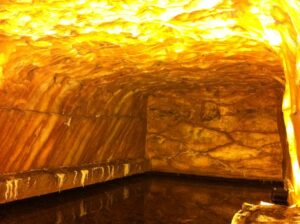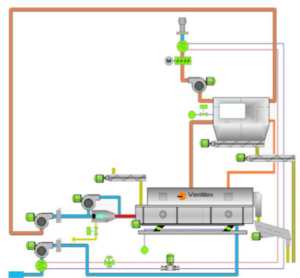Things to consider when purchasing salt drying equipment
Driven by its ample applications across multiple industries, global salt production is expected to continue its growth in the coming years. However, salt drying comes with several challenges. If left unsolved, these challenges are bound to result in higher costs. Which salt drying issues can you expect, and how can you prevent these? Moreover, when purchasing salt drying equipment, which specifics should you take into account?
Global salt production: from food preservation to chemical processes
According to Merchant Research and Consulting LTD, about two-thirds of the global salt production is consumed by the chemical industry, followed by road de-icing and food sectors. Industrial salt is also used in the dyeing of textiles, the production of paper pulp, in agricultural processes, and oil and gas drilling. Amongst other applications we should add, as this overview is far from complete. Therefore, it is no surprise that between 1975 and 2018, global salt production increased from 162 million metric tons to 300 million metric tons, as computed by Statista.
Moreover, between 2019 and 2023, the production is expected to grow with 35.43 million metric tons, says Business Wire, based on research conducted by Technavio. The growth of the salt market is predominantly due to increasing industrial applications.

Global salt market 2019 – 2023. Source: Business Wire based on research conducted by Technavio.
With these numbers in mind, we believe it is high time to provide the industry with knowledge about salt production techniques and, more specifically, salt drying processes. You will know that salt is among the most abrasive products to be processed – requiring ample energy and leading to high maintenance and replacement costs. However, there are more challenges, and we will get to those in a moment. First, let’s recap the salt production process.
The salt production process
Roughly speaking, there are three ways to produce salt.
Rock salt mining
First of all, salt can be found in salt layers, or veins. These are underground waterways that dried up a long time ago, leaving behind salt deposits. Alternatively, salt is mined from so-called domes: cave-like hollows that were formed by the movement of the earth. Both the veins and the domes vary in depth from 100 meters to 1.5 kilometers.
Rock salt extraction can be done in two ways. Continuous mining includes the use of cutting picks to shear salt from the rock’s surface. Drill-and-blast mining involves the use of explosives to break the salt into large rocks. These rocks are then further reduced in size before they are transported to the surface. There, they are sorted, based on their size, and shipped to customers.
Whether continuous mining methods or drill-and-blast techniques are used, rock salt mining is potentially dangerous: the domes and veins could cave in when the salt is extracted. That’s why many companies nowadays use the room-and-pillar method: they dug out a ‘room’ to mine in and leave solid ‘pillars’ to support the roof of the cavern.

Khewra Salt mine, Pakistan. Source: Wikipedia Commons
Solution mining
Salt can also be produced by solution mining. In this method, the salt layers are not excavated. Instead, water is pumped into bore-holes, dissolving the salt to create brine. The saturated raw brine is subsequently transported to a purification plant, where calcium, magnesium, and other impurities are removed before starting the salt evaporation process. Similarly to rock salt mining, solution mining creates caverns, which could potentially lead to site subsidence. However, by minutely controlling the amount of water that is pumped into the bore-hole, as well as the rate in which the brine is pumped up, this risk is minimized.
Solar evaporation
A third salt production method is solar evaporation, in which water is channeled into successive ponds, and solar evaporation is used to concentrate the brine and salt crystals form the floor of the basin. Once the salt ‘crop’ reaches its desired density, the salt is harvested, washed, and placed on a stockpile to drain.
The salt drying process
Solution mining and solar evaporation leave salt manufacturers with brine, or salt slurries. Depending on the level of pollution and the intended application, salt rocks, too, need to be washed. Consequently, all raw salt could require drying. If they do, the salt drying process often starts with salt evaporation, possibly combined with a vacuum evaporation technique. This technique has quickly gained popularity, so much so that it will contribute to the growth of the salt market in the years to come, according to the before-mentioned research by Technavio.
The salt evaporation process
At the start of the evaporation process, brine is pumped into the first of a series of vessels. These contain special steam chambers. The heat of the introduced steam causes the brine to boil and the water to evaporate. In turn, this produces more steam. It also causes salt crystals to grow. These salt crystals and associated brine slurry are fed into a second vessel, where the process is repeated. At Ventilex, we use exhaust steam from the first vessel, but this is not standard procedure. We lower the pressure and boiling temperature successively through the various evaporators.
The final ones operate under vacuum. In these vacuum pans, or vacpans, the brine boils at much lower temperatures, which save significant amounts of fuel. The salt crystals and slurry from the final vessel are fed into a centrifuge to extract more moisture. The resulting, undried vacuum salt is then stored in bulk for supply to the chemical industry. This is the drying process for industrial salt.
An extra drying step for food-grade salt: the fluid bed salt dryer
Food-grade salt, as well as salt for other applications, needs to be drier than industrial salt. Therefore, the undried vacuum salt from the centrifuges is fed into another dryer. Various drying systems can be used. At Ven ilex, we advise the use of a fluid bed salt dryer, which also houses a cooling section.
In this salt dryer, hot air is blown through a layer of undried salt. This cross-flow maximizes the heat transfer from the drying air to the salt, rendering this one of the most efficient drying processes. The air velocity of the drying air is adjusted in such a way that the product layer remains fluidized. The same principle applies for the cooling process, in which ambient air, or conditioned (cooled) air, is blown through the salt layer.

Flowsheet of a Vent ilex Fluid bed salt dryer with re-circulation (heat recovery) of exhaust air from the cooling section, combined with controlled evaporative cooling.
After this extra drying process, the salt is sieved and graded – iodine can be added at this stage – before it is transferred to large storage hoppers or silos, ready for distribution in bulk and bags.
Issues with salt drying
As is the case with all drying processes, the salt evaporation process, followed by additional drying in a fluid bed salt dryer, is not without its challenges.
Salt drying at overly high, or low, temperatures
For one, the appropriate temperatures need to be maintained. If salt is dried at overly high temperatures, it will take a long time to cool down sufficiently to be distributed. Slow salt cooling results in longer production times, limiting output and revenue. However, if salt cooling is not done properly, after-cooling will occur, leading to surface condensation of the salt crystals. The crystals will reabsorb the moisture, which will lead to clumps, or salt bridges, that are difficult to remove from the silo.
High temperatures may lead to clumps, but so does drying at temperatures that are too low. In this case, not enough moisture is removed, and, again, salt bridging will occur. To discover the ideal drying temperatures, advanced PLC control is required. As a result, you will deliver optimal product quality while minimizing product loss.
Maintaining desired purity of salt
Another challenge that salt manufacturers may face has got to do with the purity of salt. On the one hand, impurities need to be removed for the salt to be used in subsequent processes. On the other, a salt manufacturer might wish to preserve certain components. Components that risk damage by drying, fine milling, or other processes. In both cases, adequate solutions need to be found. The case study below is a good example.
Case study: enabling fine milling, while maintaining the mineral compounds
A salt producer in Slovenia produced salt through solar evaporation. This salt had a particularly high concentration of minerals, including magnesium and calcium. These ‘impurities’ gave the salt its unique flavor, so they were by no means to be removed from the final product. However, due to the high magnesium content, the raw salt crystals were too wet to be easily milled into finer products. This was unfortunate, as the demand for finely milled products is nearly five times that of coarse salt.
Ventilex was contracted to provide an industrial drying solution that would reduce the moisture content without reducing, or damaging, the natural mineral compounds contained in the salt. In cooperation with the customer, and with extensive bench scale testing in their laboratory, Ventilex developed a process based on long residence times at lower temperatures. This process achieved an outlet moisture content in the product of 0.5-0.8% without significant reduction in product quality. We built the installation and it performed as expected, or better, against all process guarantees, including product outlet moisture content and chemical composition, gas usage, and noise pollution. The specialized controls, developed by Trecom for Ventilex, provided a surprisingly refreshing experience for the customer’s operators and management, summed up in the following statement:
‘At first I expected one or two operators to have to always be watching the drying process for problems and small changes. But now I can come into the control room and there is sometimes no one here at all! The machine effectively runs itself!’
Producing food-grade salt
When you produce food-grade salt, you need to ensure that bacteria, molds, and other pathogens cannot grow inside the salt drying equipment. Stainless steel is a good option, as are continuous-welded and polished product parts. As regular cleaning is important, quick disassembly is vital to avoid unnecessary downtime. The Ventilex salt dryers are built with a quick-release design to allow swift and user-friendly dismantling, as well as cleaning-in-place (CIP) systems that make disassembly redundant.
Loss of product
Are you solution mining? Then you might wish to clean the exhaust air from the dryer using a wet scrubber. This will generate a saltwater solution that can be fed back into the previous stages of the production. In other instances, you might want to make use of cloth filters. These can feed the salt directly to the end product, limiting product loss.
Material wear and tear
Corrosion of steel is another big challenge in salt production. Moreover, the abrasive nature of the product leads to fast wearing and, subsequently, high maintenance, frequent downtime, and major replacement costs. A long equipment life span starts with a clever choice of materials – materials that are not prone to steel corrosion and can withstand the grating and abrasion that comes with mineral drying. At Ventilex, the unique shaking motion of our fluid bed is extremely gentle, generating the least amount of stress possible to the product, the equipment and the surrounding area.
High energy use
As a final challenge, we have listed the high energy use of salt dryers. To evaporate and fully dry salt, the brine needs to be heated multiple times before it is cooled. These processes take up energy, so it pays off to invest in energy-saving equipment. The Ventilex salt dryer typically leads to a 30-60% energy cost reduction. Also, the exhaust air from the cooler area is recycled to the drying area, so that excess heat energy in the product is reclaimed in the dryer.
Purchase salt drying equipment
In short, whether you are purchasing a salt dryer, a brine evaporator or other salt drying equipment, we would advise you to take the following considerations in mind:
- As both overly high or low temperatures lead to suboptimal product quality, advanced PLC control is necessary to maintain optimal drying temperatures.
- Work with a salt dryer manufacturer that understands your product and can help you set up processes that maintain the product characteristics you are after.
- Are you producing food-grade salt? Then make sure to use stainless steel and continuous-welded, polished product parts.
- There are processing solutions that help you minimize product loss. Ask your supplier about these options.
- Require into the best choice of materials – they should withstand steel corrosion as well as rough processing conditions.
- Make sure that your salt dryer can be easily disassembled to allow for swift cleaning and/or maintenance.
- It should also enable processing conditions that are as gentle as possible, to prevent unnecessary wear and tear.
- To limit environmental impact and reduce costs, opt for equipment and processes that reclaim excess heat energy and are as energy-efficient as possible.
Get in touch
Optimize your salt drying process
At Ventilex, we pride ourselves in collaborating closely with our customers. As a result, we can advise you on the optimal choice of materials, and carry out your exact wishes. Also, our test engineers can help you optimize your drying process, both in our test center in the Netherlands and at your site. Would you like to find out how they can help you optimize your salt dryer? Reach out to us.
If you would like to learn more about the Ventilex salt dryer or have any questions about this article, we welcome you to contact us at any time!